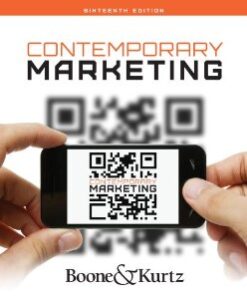Test Bank for Entrepreneurship The Practice and Mindset, 2nd Edition, Heidi M. Neck, Christopher P. Neck, Emma L. Murray, ISBN: 9781544354668, ISBN: 9781544354620, ISBN: 9781071804322
$35.00
Test Bank for Entrepreneurship The Practice and Mindset, 2nd Edition, Heidi M. Neck, Christopher P. Neck, Emma L. Murray, ISBN: 9781544354668, ISBN: 9781544354620, ISBN: 9781071804322
SKU: xnuoz392956
Category: Test Bank
Test Bank for Entrepreneurship The Practice and Mindset, 2nd Edition, Heidi M. Neck, Christopher P. Neck, Emma L. Murray, ISBN: 9781544354668, ISBN: 9781544354620, ISBN: 9781071804322
Table Of Content
Preface
Acknowledgments
About the Authors
Part I. Entrepreneurship Is a Life Skill
CHAPTER 1: Practicing Entrepreneurship
1.1 Entrepreneurship Requires Action and Practice
1.2 Entrepreneurship May Be Different From What You Think
1.3 Types of Entrepreneurship
1.4 Entrepreneurship Is a Method, Not a Process
1.5 The Method Involves Creating the Future, Not Predicting It
1.6 The Key Components of the Entrepreneurship Method
1.7 Entrepreneurship Requires Deliberate Practice
1.8 How ThisWill Help You Practice Entrepreneurship
Summary
Key Terms
Case Study: Saurbh Gupta, founder, Gyan-I Inc.
CHAPTER 2: Activating an Entrepreneurial Mindset
2.1 The Power of Mindset
2.2 What Is Mindset?
2.3 The Self-Leadership Habit
2.4 The Creativity Habit
2.5 The Improvisation Habit
2.6 The Mindset as the Pathway to Action
Summary
Key Terms
Case Study: Maliha Khalid, founder and CEO, Doctory
Part II. Creating and Developing Opportunities
CHAPTER 3: Creating and Recognizing New Opportunities
3.1 The Entrepreneurial Mindset and Opportunity Recognition
3.2 Opportunities Start With Thousands of Ideas
3.3 Four Pathways to Opportunity Identification
3.4 Alertness, Prior Knowledge, and Pattern Recognition
3.5 From Idea Generation to Opportunity Recognition
Summary
Key Terms
Case Study: Jillian Lakritz, founder, Yoee Baby
CHAPTER 4: Using Design Thinking
4.1 What Is Design Thinking?
4.2 Design Thinking as a Human-Centered Process
4.3 Design Thinking Requires Empathy
4.4 The Design-Thinking Process: Inspiration, Ideation, Implementation
4.5 Pathways Toward Observation and Insights
4.6 Interviewing as a Useful Technique for Identifying Needs
4.7 Variations of the Design-Thinking Process
Summary
Key Terms
Case Study: Anton Yakushin, cofounder and CEO, VentureBlocks
CHAPTER 5: Building Business Models
5.1 What Is a Business Model?
5.2 The Four Parts of a Business Model
5.3 The Customer Value Proposition (CVP)
5.4 Different Types of CVPs and Customer Segments
5.5 The Business Model Canvas (BMC)
Summary
Key Terms
Case Study: Gautam Gupta, cofounder, NatureBox
CHAPTER 6: Developing Your Customers
6.1 Customers and Markets
6.2 Types of Customers
6.3 Customer Segmentation
6.4 Target Customer Group
6.5 Customer Personas
6.6 Customer Journey Mapping Process
6.7 Market Sizing
Summary
Key Terms
Case Study: Haim Saban, The Mighty Morphin’ Power Rangers
CHAPTER 7: Testing and Experimenting With New Ideas
7.1 Experiments: What They Are and Why We Do Them
7.2 Types of Experiments
7.3 A Deeper Look at Prototypes
7.4 Hypothesis Testing and the Scientific Method Applied to Entrepreneurship
7.5 The Experimentation Template
7.6 Interviewing for Customer Feedback
Summary
Key Terms
Case Study: Katrina Lake, CEO, Stitch Fix
CHAPTER 8: Developing Networks and Building Teams
8.1 The Power of Networks
8.2 The Value of Networks
8.3 Building Networks
8.4 Virtual Networking
8.5 Networking to Build the Founding Team
Summary
Key Terms
Case Study: Jeff Goudie, AmeriCan Packaging
Part III. Evaluating and Acting on Opportunities
CHAPTER 9: Creating Revenue Models
9.1 What Is a Revenue Model?
9.2 Different Types of Revenue Models
9.3 Generating Revenue From “Free”
9.4 Revenue and Cost Drivers
9.5 Pricing Strategies
9.6 Calculating Price
Summary
Key Terms
Case Study: Balaji Viswanathan, founder, Invento Robotics
CHAPTER 10: Planning for Entrepreneurs
10.1 What Is Planning?
10.2 Planning Starts With a Vision
10.3 Plans Take Many Forms
10.4 Questions to Ask During Planning
10.5 The Business Plan Debate
10.6 Tips for Writing Any Type of Plan
Summary
Key Terms
Case Study: Boyd Cohen, cofounder, IoMob
CHAPTER 11: Anticipating Failure
11.1 Failure and Entrepreneurship
11.2 The Failure Spectrum
11.3 Fear of Failure
11.4 Learning From Failure
11.5 Getting Gritty: Building a Tolerance for Failure
Summary
Key Terms
Case Study: Emily Lagasse, founder, Petwell Supply Co.
Part IV. Supporting New Opportunities
CHAPTER 12: Bootstrapping and Crowdfunding for Resources
12.1 What Is Bootstrapping?
12.2 Bootstrapping Strategies
12.3 Crowdfunding Versus Crowdsourcing
12.4 Crowdfunding Startups and Entrepreneurships
12.5 The Four Contexts for Crowdfunding
12.6 A Quick Guide to Successful Crowdfunding
Summary
Key Terms
Case Study: Daymond John, founder, FUBU
CHAPTER 13: Financing for Startups
13.1 What Is Equity Financing?
13.2 The Basics of Valuation
13.3 Angel Investors
13.4 Venture Capitalists
13.5 Due Diligence
Summary
Key Terms
Case Study: Rich Palmer, founder, Gravyty
SUPPLEMENT A: Financial Statements and Projections for Startups
Financial Projections for Startups
Three Essential Financial Statements
Linkages Between the Three Financial Statements
The Journey of Cash: The Cash Conversion Cycle
Building Pro Forma Financial Statements
Building Assumptions: Operating Policies and Other Key Assumptions
Summary
Key Terms
CHAPTER 14: Navigating Legal and IP Issues
14.1 Legal Considerations
14.2 Types of Legal Structures
14.3 Legal Mistakes Made by Startups
14.4 Intellectual Property (IP)
14.5 Global IP Theft
14.6 Common IP Traps
14.7 Hiring Employees
Summary
Key Terms
Case Study: Matthew Vega-Sanz, cofounder, Lula
CHAPTER 15: Engaging Customers Through Marketing
15.1 What Is Entrepreneurial Marketing?
15.2 The Basic Principles of Marketing
15.3 Building a Brand
15.4 Entrepreneurial Marketing
15.5 Creating Your Personal Brand
Summary
Key Terms
Case Study: Justin Real, founder, Realplay
SUPPLEMENT B: The Pitch Deck
Types of Pitches
Overview of the Pitch Deck
The Pitch Deck
The Question and Answer Period
Public Speaking Tips
Summary
Key Term
CHAPTER 16: Supporting Social Entrepreneurship
16.1 The Role of Social Entrepreneurship
16.2 Social Entrepreneurship and Wicked Problems
16.3 Types of Social Entrepreneurship
16.4 Capital Markets for Social Entrepreneurs
16.5 Social Entrepreneurs and Their Stakeholders
16.6 Differences Between Social Entrepreneurship and Corporate Social Responsibility
16.7 Social Entrepreneurship and Audacious Ideas
16.8 Global Entrepreneurship
Summary
Key Terms
Case Study: Brandale Randolph, founder and CEO, 1854 Cycling Company
Glossary
Notes
Name Index
Subject Index
Be the first to review “Test Bank for Entrepreneurship The Practice and Mindset, 2nd Edition, Heidi M. Neck, Christopher P. Neck, Emma L. Murray, ISBN: 9781544354668, ISBN: 9781544354620, ISBN: 9781071804322” Cancel reply
Related products
$35.00
$35.00
$35.00
$35.00
$35.00












Reviews
There are no reviews yet.